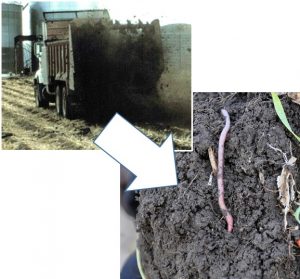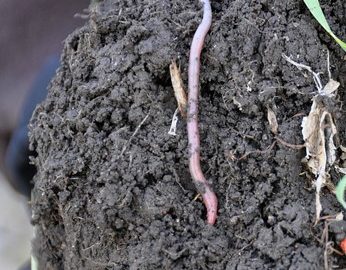Manure Impact on Soil Aggregation
If manure increases formation of larger (macro) and more stable soil aggregates, several benefits may result for fields fertilized by manure compared to commercial fertilizer including:
- Reduced runoff and soil erosion;
- Increased water infiltration into the soil possibly leading to greater drought tolerance; and
- Partial offsetting of higher soil P levels resulting from manure application and limiting P loss to local surface water.
The Manure and Soil Health blog will unpack some of the potential benefit of manure to soil quality by reviewing past research for clues as to manure’s benefits. Several research studies have documented manure application impact on improvement of soil physical properties. This blog article examines published research by Charles Wortmann and Charles Shapiro, The Effects of Manure Application on Soil Aggregation.
Wortmann and Shapiro conducted studies at three separate Nebraska farms to explore the impact of composted beef manure, stockpiled beef manure and swine manure on soil aggregate size. Their hypothesis proposed that manure will produce increased macro-aggregate formation with the intent of learning 1) how quickly these aggregates form, 2) impact of alternative manure sources, and 3) the residual effects of manure on aggregates. Three studies were conducted with silty loam or silty clay loam soils. Feedlot manure solids was applied at 20 to 22 dry tons/acre (roughly 40 to 44 wet tons/ac) and swine manure at 1.2 dry tons/acre (roughly 4800 gallons per acre if manure is 6% solids). Four conclusions were drawn providing clues about manure’s benefits.
Water stable large macro-aggregates were increased 2 to 3 times for manured soils compared to commercially fertilized soils.

Figure 1. Manure improves soil physical properties such as soil aggregate formation. Photo courtesy of USDA NRCS Soil Health flickr collection.
All macro-aggregates increased by 10 to 20% for manured vs commercially fertilized soils (see Figure 1). This increase was consistent across all soil types evaluated. A Michigan State Extension publication suggests that “When manure … is added to the soil it is quickly colonized by millions of bacteria…bacteria producing large quantities of polysaccharides. These polysaccharides function like sticky glue in the soil and can actually stick particles together into aggregates.”
The formation of macro-aggregates occurred with all manures with some advantage for compost and similar effects for raw feedlot manure and swine slurry.
The swine manure’s solids application rate was only 6% of that of feedlot manure but still achieved very similar benefits. This might suggest that achieving the physical soil property benefits may be more dependent upon the rapid growth in soil micro-biology and less dependent on the total solids in the manure.
Water-stable macro-aggregates formed within 15 days after manure application, persisted over a 7 month observation period, but were no longer found on a separate tilled site that was without compost for 5 years.
The effect of manure or compost on macro-aggregate formation soon after application (first observation made at 15 days) suggests an immediate value from manure application. The study observed this benefit lasted at least 7 months but disappearing five years later. Other research has suggested this benefit lasts longer in no-till fields.
Phosphorus was observed to concentrate in the water-stable macro-aggregates, twice as great in the large aggregates as the whole soil P level.
This may provide additional protection resulting from manure for holding P in the soil and reducing P in runoff. However, previous research has documented that P movement from cropland is connected to soil surface P levels. Managing manure to keep soil P levels low, near levels required for optimum crop production, remains our best practice for protecting water quality. But manure’s large aggregate building response and P concentration in those large aggregates help protect water quality.
This article demonstrates the take home message that manure improves the physical characteristics of our soils not experienced with commercial fertilizer. These improvements to the soil aggregates opens the possibility for environmental and economic benefits. This possibility will be explored in future MaSH blogs.
Author: Rick Koelsch, University of Nebraska – Lincoln
Reviewers: Charles Wortmann and Charles Shapiro, University of Nebraska – Lincoln
Funding support from North Central Region Water Network.

Was the manure in these tests biologically treated while in the manure storage facility? When the manure is biologically treated while in storage the nutrient cycling process is started. The microbes can break down the manure, capture and hold the nutrients until applied to the soil, reduce many negative issues with manure storage, and are facultative meaning they work in the manure and the soil as most are indigenous to the soil rhizosphere. Less time is needed for the manure to simulate into the soil profile. So if you are using manure as fertilizer, why not make the manure more compatible to the soil with the microbes from the soil that would break down the manure when applied while the manure is in storage. The often missed value of manure is the trace elements in the manure coming back into a trace mineral deficient soil. Soil microbes have to have these nutrients for there own survival – when they are healthy the growing plants are healthier.
My apologies for not seeing this post earlier.
The manure in two of these tests was not biologically treated. The bacteria would likely have been primarily anaerobic bacteria having originated in the intestinal track of the animal or during manure storage. One treatment used composted beef solids which may have a mix of aerobic and anaerobic bacteria. The research article does not mention how long the compost had been stored prior to land application. Storage for any length of time would likely have caused anaerobic conditions to return. My expectation is that they manures used would be representative of manures from many animal facilities and the resulting aggregation of soils would representative of the results one would expect from animal manures that had been in storage.
In general, we do not see significant solids reduction in manure storage from biological processes. Unless we design a liquid system with significant dilution and a permanent pool for maintaining anaerobic activity such as in a lagoon, bacterial breakdown of solids is modest. In solids manure, similar solids breakdown is modest unless we introduce oxygen to stockpiled solids to allow aerobic composting. The potential always exists for solids breakdown but the conditions in most stored manure are generally not conducive to significant activity.
This does change quickly following land application when aerobic conditions dominate. With the manure’s organic matter providing the energy and soils providing a good aerobic environment, the conditions are ripe for a lot of bacterial activity resulting in the level of soil aggregation observed in this study. The observation that soil aggregation changed dramatically in the first 14 days with no change after that suggests to me that prior biological treatment of stored manure is likely to NOT be important to achieving the results observed in this study.